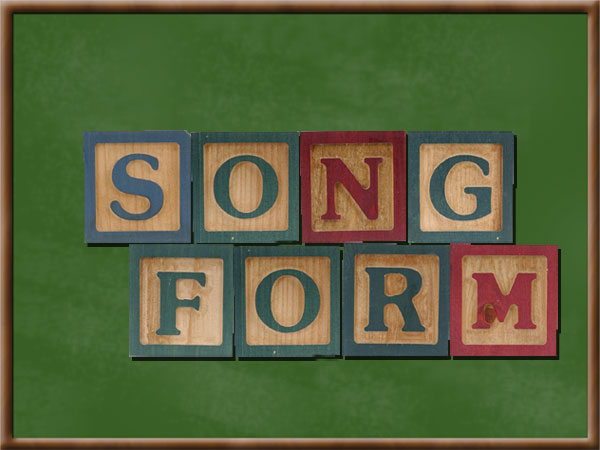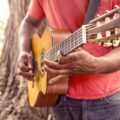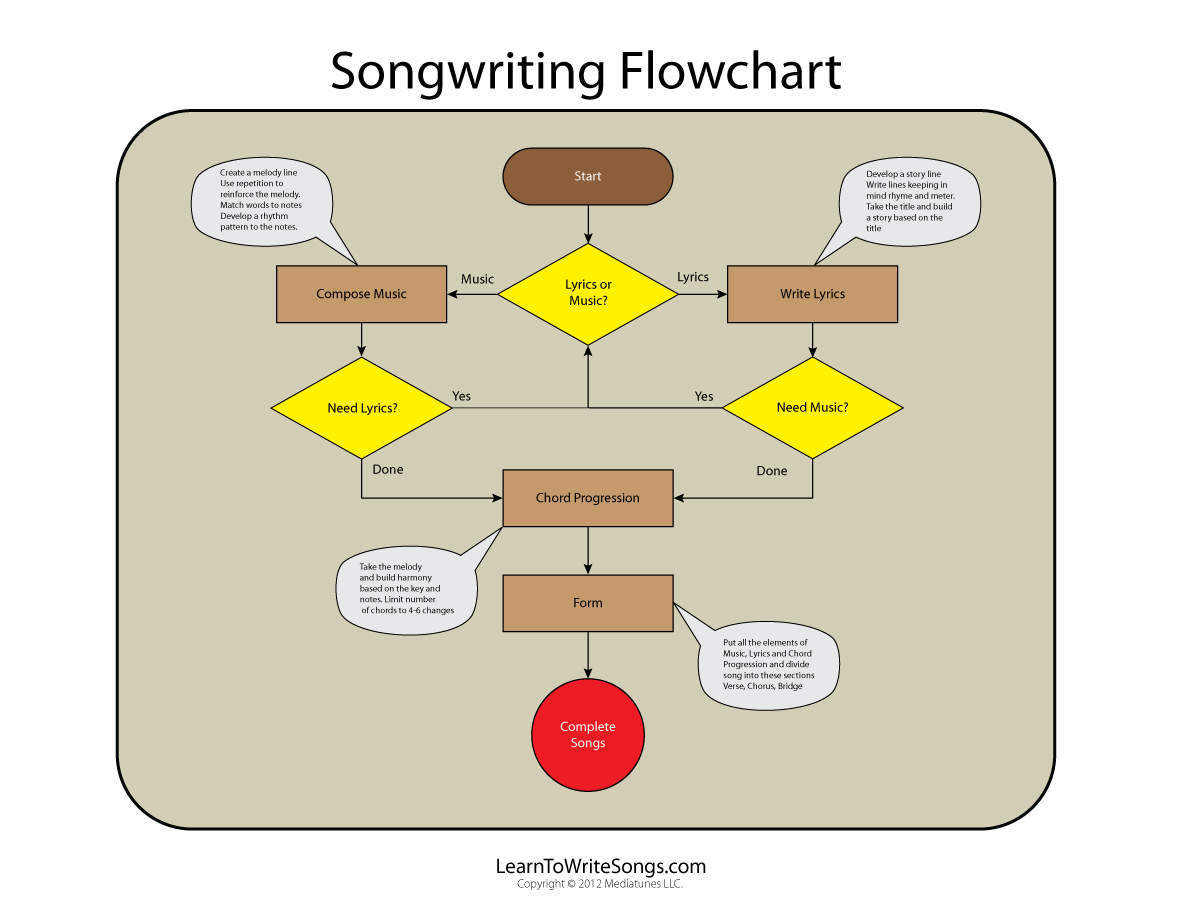Structure Great Content by Using Music Writing Techniques

This publication is written with the assumption that you know what a subject and verb is and you understand sentence structure for proper grammar and punctuation. My intent with this publication is to help you use your basic knowledge to structure content in the same manner used by musicians by using music writing techniques.
Learn to Write Like Musicians
Tales have been told about songwriters who sat at a bar with a pen and a napkin and wrote a song that hit the top of the charts, selling millions of records on the first day it was released. We want to believe the artist was struck with pure luck when that happens. The truth is, a lot of structure goes into writing a song.
I will be sharing concepts like, Intro, Verse, Chorus, Collision, Bridge, Coda, and more to help you write content using musical structure that, when applied to writing can strengthen and enhance your writing experience. My hope is that I am able to help you produce content that is stronger and flows more like a song than mere words on a page.
I hope that I am able to help you save time when structuring the beginning, middle, and end of your publication by using these simple techniques.
Listen to Good Music and Read Good Writers
The first tip, “Familiarize Yourself With Other Artists,” may sound like something I pulled out of a hat. The truth is, out of all the tips shared in this publication, this tip is probably the most important one. It is, surely, where you want to start in order to become knowledgeable about what a good song sounds like and how a good song is structured. With this knowledge, you can create a base upon which you can grow and build a more solid structure.
Familiarize Yourself With Other Artists
Musicians listen to other musicians. A song that is on the Billboard’s Top Ten Chart is there for a reason. It is there because people enjoy the song and pay money to listen to that song. So, it makes sense to listen to top performing songs to discover what makes it so popular.
Familiarization as it is applied to content writing – In the same sense that musicians listen to music, writers must read the content that other writers write. Read the works of famous writers such as Lord Byron, Maya Angelou, Shakespeare, and Tennessee Williams. All of these writers are famous for creative structure of their sentences and paragraphs written in such a way that when you read them, they sound like musical lyrics.
Tell a Story
We all have a story worth sharing, but no matter how great your story, if it is not well-written, you may not have many readers. Write like a musician to draw readers in and have them wanting to read everything you write.
The story
When a song writer sets out to write a song, he or she normally has a single-focused, distinct story to tell. Have you listened to any Taylor Swift songs lately? If so, you know many of her songs are about how her boyfriend did her wrong. The song titled, “Happy,” by Pharrell Williams is a song about being happy. No matter what song you hear, there is one definitive story to tell or message to convey.
The story as it is applied to content writing – When you write content, write with one story or message in mind. Be clear about what you intend to convey to the reader and write about that subject only.
If you are an online content writer, then you have an even greater responsibility with regard to the story or message. Online readers have a short attention span. You only have a few seconds, at most to capture their attention. After that, you only have a few minutes to keep them interested in reading your message. Be succinct, tell them the story or message they are going to receive and then deliver it quickly or you will lose them.
Attention Span of Internet Readers
- 49% of readers read an average of 593 words per web page.
- Readers will only spend 2.4 seconds more for each additional 100 words.
By the way, a typical song length is no longer than four minutes. Likewise, if you are an online writer, you want to write publications that are approximately 1500 to 2000 words or less. Longer publications are alright, so long as the information is valuable throughout the publication. Considering the attention span of most online readers, whenever you can convey your message succinctly, it is best to do so. You’ve got to capture the reader’s attention quickly and keep their attention throughout your publication.
If you find that you have a lot of content to share about a subject, then it might be wise to divide the content into different parts.
Music Components of Music Writing Techniques
Music has various components generally known as, Intro, Verse, Chorus, Bridge, and Coda.
Brief explanation of music components
- Intro – The Intro is the opening of the song. It is used to bring the listener into the song.
- Verse – The Verse is a set of lyrics set to a segment of music. There can be multiple verses in a song.
- Chorus – The Chorus is a set of lyrics set to a segment of music that is different than the verse. The course remains the same throughout the song.
- Bridge – The Bridge connects the verse and chorus. It is a contrast with the verse.
- Collision– The Collision is a dramatic section of music that breaks up the monotony of the song.
- Coda – The Coda is also known as the outro and is a way of ending the song.
Develop a Format or Structure
When you listen to a song, you can recognize the format (structure) of the song. Musicians are free to structure songs in whatever sequence fits the needs of the song. Still, it is typical to format a song using the following structure:
Intro / Verse / Chorus / Verse / Chorus / Bridge / Verse / Coda
I really want you to listen to this song titled, “Who Loves You,” by Frankie Valli & The Four Seasons. It is a great song and you will become familiar with music structure by listening. The song is just over four minutes long and is a valuable listening tool. Plus, I think you will enjoy it a lot.
Structure as it is applied to content writing – Writers use sentence structure to format a flow. We write simple sentences. We write complex sentences. Some sentences are long. Some are short. We punctuate, articulate, accentuate, and more. Everything we do attributes to the flow in a way that when your content is read, the flow contributes to the overall experience of the reader.
For example, you can use short sentences to generate excitement or urgency. Use longer sentences to portray mellow circumstances. You can stretch out a sentence to create drama and write as if you are not in a hurry to get to the end of the sentence. Use interjections like, “ah” to express a sudden emotion, or “so” to help the reader pause. Even using contractions can be effective in helping create the flow you desire.
Just like most songwriters write an Intro, Verse, Chorus, and Coda, make sure the content you write has a well-defined beginning, middle, and end.
The Beginning (Intro)
Every song has a beginning. The beginning can be instrumental or a cappella (without instrumentation). The beginning of the song is designed to bring the listener into the song. It can be soft or dynamic. However, the song is introduced, the intro’s purpose is to engage the listener so that they want to hear more of the song.
The Intro as it is applied to content writing – Invite readers into your content. At the very beginning of your publication, let the readers know what they will be reading. Tell the reader exactly what you are going to cover in your content. Consider the reader’s curiosity. Assure the reader that you are a credible source for the content they are about to read. Share a little about your expertise or how you are connected with the content. This will validate you as a credible writer for the subject you are sharing and set the reader’s mind at ease as they continue reading your publication. Remember, this is just an introduction, so keep it short, sweet, and to the point.
The Middle (Verses)
A song usually has several verses. While lyrics in the verses are normally set to the same style of music, each verse has a different set of lyrics. The message is still the same, but the lyrics in each verse move the song along to convey a complete message.
The Verses as they are applied to content writing – I like to think of verses as the sentences that comprise the paragraph. While each paragraph is different, each paragraph moves the story or message along. Each paragraph leads the reader through the content to a place where the reader has received the ultimate promise given in the introduction of the publication.
Accompanying Material (The Bridge)
In music, the bridge connects the verse and chorus. The bridge can be all instrumental, a capella, or whatever the musician wants. It is a musical component that is designed to bring the verse and chorus together in a creative manner. Not every song has a bridge. It is a component that is used in songs where doing something different makes the song more interesting.
The Bridge as it is applied to content writing – When writing content, writers have an opportunity to include accompanying material, such as photos, videos, quotes, biographies, interviews, tables, charts, almost any material that enhances the story or content. A video pertaining to the subject can be entertaining, yet give the reader a break from reading, a chance to think, or a chance to become more engaged with your material. Include visual aids. They are a way to tie thoughts together and enhance your content.
Spice up Your Content (Collision)
In music, a collision is a section of music that is meant to be dramatic. It breaks up the monotony of the song.
The Collision as it is applied to content writing – Spice up your content. Spark some kind of elevated emotion or interest in your content. This can be done with remarks or accompanying photos, videos, or quotes that create additional interest or drama. The collision is a little different than the bridge. The bridge is designed to validate your story. While the Collision can be used to validate your story, the Collision is designed to stir things up. The Collision can be a place where you could insert your candid and passionate opinion or plea. You could also use the Collision to share the opinion of someone else who has a strong opinion for or against your content. The Collision is an optional component that can be effective in keeping a reader’s attention.
The End (Coda)
Rather than abruptly ending a song, musicians end a song in a number of ways. They may do a simple fade-out where the song ends on a progressively quiet note. They may sing a portion of the chorus or a portion of the verse. Or, they may sing an entirely different stanza designed specifically to be sang at the end of the song.
The Coda as it is applied to content writing – In writing, the writer wants to give a recap of the content. Summarize what was written and what you hope the reader gained from reading your story or content.
Write Like a Musician
As you can see, a lot of structure goes into writing a song. I hope that now you are able to write like a musician, applying the music writing techniques of song writing to content writing in a way that produces great content that readers want to read.
Anthony Floyd – artist and traveler around all world. Anthony has already visited 15 countries. His hobby is writing, so now he is a freelance writer in company where you can buy essay online. He likes to play on piano and listen to music.






Leave a Reply